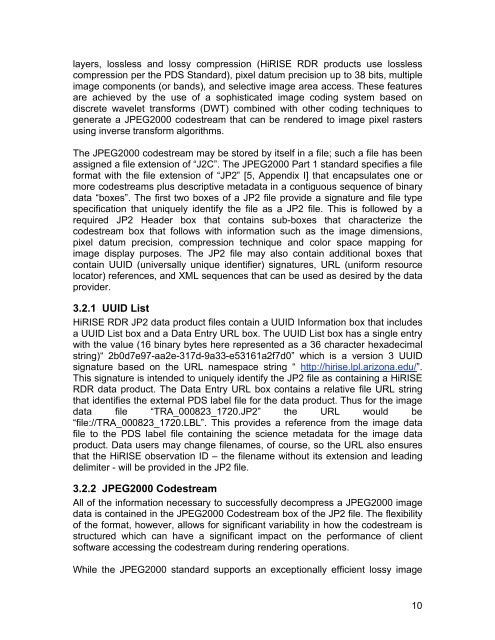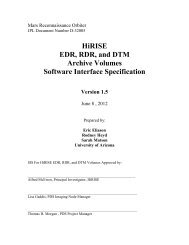Software Interface Specification for HiRISE Reduced Data Record ...
Software Interface Specification for HiRISE Reduced Data Record ...
Software Interface Specification for HiRISE Reduced Data Record ...
Create successful ePaper yourself
Turn your PDF publications into a flip-book with our unique Google optimized e-Paper software.
layers, lossless and lossy compression (<strong>HiRISE</strong> RDR products use lossless<br />
compression per the PDS Standard), pixel datum precision up to 38 bits, multiple<br />
image components (or bands), and selective image area access. These features<br />
are achieved by the use of a sophisticated image coding system based on<br />
discrete wavelet trans<strong>for</strong>ms (DWT) combined with other coding techniques to<br />
generate a JPEG2000 codestream that can be rendered to image pixel rasters<br />
using inverse trans<strong>for</strong>m algorithms.<br />
The JPEG2000 codestream may be stored by itself in a file; such a file has been<br />
assigned a file extension of “J2C”. The JPEG2000 Part 1 standard specifies a file<br />
<strong>for</strong>mat with the file extension of “JP2” [5, Appendix I] that encapsulates one or<br />
more codestreams plus descriptive metadata in a contiguous sequence of binary<br />
data “boxes”. The first two boxes of a JP2 file provide a signature and file type<br />
specification that uniquely identify the file as a JP2 file. This is followed by a<br />
required JP2 Header box that contains sub-boxes that characterize the<br />
codestream box that follows with in<strong>for</strong>mation such as the image dimensions,<br />
pixel datum precision, compression technique and color space mapping <strong>for</strong><br />
image display purposes. The JP2 file may also contain additional boxes that<br />
contain UUID (universally unique identifier) signatures, URL (uni<strong>for</strong>m resource<br />
locator) references, and XML sequences that can be used as desired by the data<br />
provider.<br />
3.2.1 UUID List<br />
<strong>HiRISE</strong> RDR JP2 data product files contain a UUID In<strong>for</strong>mation box that includes<br />
a UUID List box and a <strong>Data</strong> Entry URL box. The UUID List box has a single entry<br />
with the value (16 binary bytes here represented as a 36 character hexadecimal<br />
string)“ 2b0d7e97-aa2e-317d-9a33-e53161a2f7d0” which is a version 3 UUID<br />
signature based on the URL namespace string “ http://hirise.lpl.arizona.edu/”.<br />
This signature is intended to uniquely identify the JP2 file as containing a <strong>HiRISE</strong><br />
RDR data product. The <strong>Data</strong> Entry URL box contains a relative file URL string<br />
that identifies the external PDS label file <strong>for</strong> the data product. Thus <strong>for</strong> the image<br />
data file “TRA_000823_1720.JP2” the URL would be<br />
“file://TRA_000823_1720.LBL”. This provides a reference from the image data<br />
file to the PDS label file containing the science metadata <strong>for</strong> the image data<br />
product. <strong>Data</strong> users may change filenames, of course, so the URL also ensures<br />
that the <strong>HiRISE</strong> observation ID – the filename without its extension and leading<br />
delimiter - will be provided in the JP2 file.<br />
3.2.2 JPEG2000 Codestream<br />
All of the in<strong>for</strong>mation necessary to successfully decompress a JPEG2000 image<br />
data is contained in the JPEG2000 Codestream box of the JP2 file. The flexibility<br />
of the <strong>for</strong>mat, however, allows <strong>for</strong> significant variability in how the codestream is<br />
structured which can have a significant impact on the per<strong>for</strong>mance of client<br />
software accessing the codestream during rendering operations.<br />
While the JPEG2000 standard supports an exceptionally efficient lossy image<br />
10




